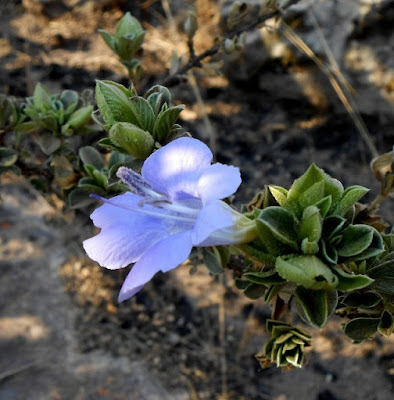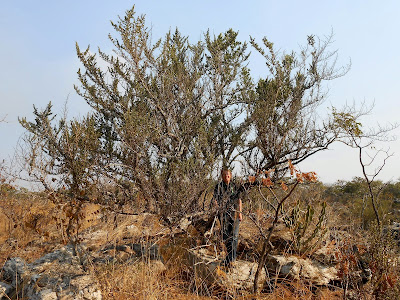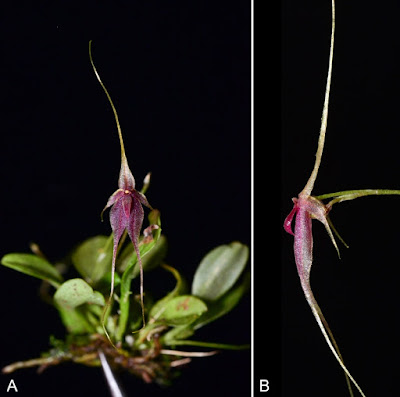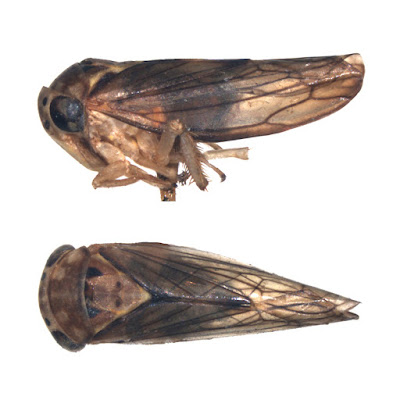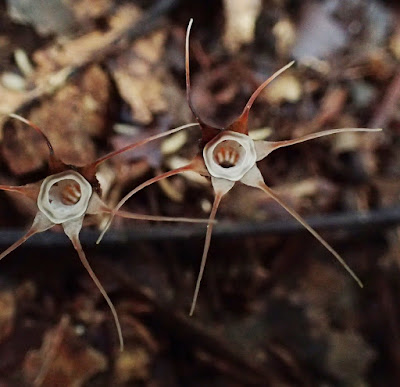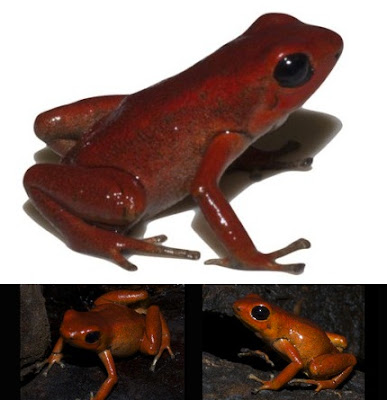[Most Recent Entries] [Calendar View]
Tuesday, July 11th, 2017
| Time | Event | ||||||
| 2:05a | [Botany • 2016] Barleria mirabilis • A Remarkable New Tree Species (Acanthaceae) from west Tanzania
Summary A new species of Barleria (Acanthaceae), discovered in 2014 on the Uzondo Plateau of West Tanzania, is described and illustrated and its affinities are discussed. This is the first documented tree species in the genus Barleria. Its conservation status is assessed using the categories and criteria of IUCN; it is considered to be globally Vulnerable. Key Words: conservation, IUCN Red List assessment, Mpanda, taxonomy, Uzondo
RECOGNITION: Barleria mirabilis is most similar to B. crassa C. B. Clarke and B. nyasensis C. B. Clarke but differs markedly from both in being a tree to 4 – 6 m tall at maturity (vs a perennial herb or shrub 0.3 – 2.5 m tall); in having broader, elliptic or oblanceolate bracteoles 3 – 5 mm wide and lacking a spine tip (vs bracteoles linear-lanceolate with a spine tip or reduced to a simple spine, 0.5 – 3 mm wide); in the bracteoles and posterior and anterior calyx lobes having numerous conspicuous capitate “mushroom” glands externally (these absent in B. crassa and B. nyasensis which only have scattered small glandular hairs on the calyx); in the anterior and posterior calyx lobes being more convex and with markedly involute, entire margins (vs calyx lobes with margin not or hardly involute; denticulate to spinulose-dentate or rarely almost entire); and in the anthers being larger (6.3 – 6.6 mm vs 3 – 5 mm long). DISTRIBUTION: Known only from the Uzondo Plateau of West Tanzania. ETYMOLOGY: The species epithet “mirabilis” (miraculous, astonishing) refers both to the fact that this is a truly remarkable species, being the only tree Barleria recorded to date, and to the fact that such a striking and locally frequent species has not been found previously despite considerable past botanical exploration at the collecting locality. Iain Darbyshire and Quentin Luke. 2016. Barleria mirabilis (Acanthaceae): A Remarkable New Tree Species from west Tanzania. Kew Bulletin. 71; 13. DOI: 10.1007/s12225-016-9622-0 | ||||||
| 2:11a | [Botany • 2017] Platystele baqueroi • A Showy New Platystele (Pleurothallidinae: Orchidaceae) from northwest Ecuador
Abstract A new species of Platystele (Pleurothallidinae: Orchidaceae) is described from foothill forest in the province of Carchi in northwestern Ecuador. The species has relatively large flowers for the genus, with long slender sepaline tails. It resembles Platystele caudatisepala, but is distinguished from that species by the partially connate lateral sepals, the convex lip with reflexed tip and margins, the deflexed petals, sometimes with their tips touching behind the flower, the sepals with recurved margins, and the leaves long-petiolate. Keywords: Carchi, Ecuador, Orchidaceae, Platystele, Pleurothallidinae
Diagnosis. Similar to the widely distributed P. caudatisepala (C. Schweinf.) Garay, but differs in its more long-petiolate leaves, lateral sepals connate for 2 mm and not divergent, petals usually strongly deflexed, with tips that often meet or cross behind the flower, and adaxial surface of lip strongly convex rather than planar. Eponymy: Named after Luis Baquero, Quito, Ecuador, enthusiastic orchidologist and conservationist who discovered this species. Lou Jost and Gabriel Iturralde. 2017. A Showy New Platystele (Pleurothallidinae: Orchidaceae) from northwest Ecuador. LANKESTERIANA. 17(1); 55-60. DOI: 10.15517/lank.v17i1.28479 Resumen. Se describe una nueva especie de Platystele (Pleurothallidinae: Orchidaceae) de los bosques piemontanos de la provincia de Carchi en el noroccidente de Ecuador. Esta especie presenta flores relativamente grandes en relación a la mayoría de las especies del género, cuyas caudas de los sépalos son largas y delgadas. Es similar a Platystele caudatisepala pero se distingue de esa especie por sus sépalos laterales parcialmente connados, el labio convexo con la punta y márgenes reflexos, los pétalos deflexos, a veces tocando sus puntas hacia atrás de la flor, los sépalos con márgenes recurvados y las hojas largamente pecioladas. | ||||||
| 5:46a | [Entomology • 2017] Philippogalla, A New Genus for Philipposcopus modestus (Baker) from the Philippines, and A New Species of Philipposcopus, P. processus (Hemiptera: Cicadellidae: Idiocerinae) from China
Abstract A new genus of Idiocerinae, Philippogalla gen. nov., is described and illustrated based on Philipposcopus modestus (Baker) from the Philippines. A lectotype is designated for P. modestus. In addition, a new species Philipposcopus processus sp. nov. is described and illustrated from China. Keywords: Hemiptera, Cicadellidae, Idiocerinae Qingquan Xue, Stuart H. Mckamey and Yalin Zhang. 2017. Philippogalla, A New Genus for Philipposcopus modestus (Baker) from the Philippines, and A New Species of Philipposcopus (Hemiptera: Cicadellidae: Idiocerinae) from China. Zootaxa. 4291(1); 34–40. DOI: 10.11646/zootaxa.4291.1.2 | ||||||
| 6:06a | [Botany • 2017] Thismia bryndonii • A New Species (Thismiaceae) from Maliau Basin, Sabah, Borneo
Thismia Griffith (1845: 341) in Thismiaceae or Burmanniaceae (sensu APG 2016) consists of more than 60 species (Ridley 1924, Jonker 1948, Stone 1980, van Steenis 1982; Merckx 2008). Many new species in this genus have been discovered, and 12 have been described after 2010 (e.g., Dančak et al. 2013, Nuraliev et al. 2014, 2015, Chantanaorrapint & Sridith 2015, Li & Bi 2013, Hroneš et al. 2015). Considering that the majority of these species were collected only once (Jonker 1948), it is likely that many more undescribed species remain hidden in the forests, particularly in the tropical rain forests of Southeast Asia. Borneo is one of the most biodiverse areas for mycoheterotrophs, and our recent botanical exploration in Borneo revealed many previously undescribed mycoheterotrophic species (e.g., Tsukaya et al. 2011, 2014a,b, 2016, Tsukaya & Okada 2005, 2012a,b,c, 2013a,b, Tsukaya & Hidayat 2016, Tsukaya & Suetsugu 2014). In 2016, we conducted a botanical survey in the Malaiu Basin, Sabah, Borneo, with the permission of the Maliau Basin Management Committee (YS/MBMC/2016/184) and the Sabah Biodiversity Council [access license JKM/MBS.1000-2/2JLD.5(23)]. The Maliau Basin Conservation Area (MBCA) is a huge basin surrounded by sandstone ridges and covers approximately 39,000 ha. Few botanical explorations have previously been conducted in this area. During the survey, we encountered a specimen from the MBCA that apparently belongs to Thismia section Euthismia Schltr. subsect. Odoardoa Schlechter (1921: 31) because it has a free inner perianth, spreading, creeping and vermiform roots, perianth lobes equal in length and size, but it differs from all known species. Here, we describe this new species with a revised key to the species of this genus in Malesia. Keywords: Borneo, Malaysia, Maliau Basin, mycoheterotrophic plant, Sabah, Thismia, Thismiaceae, Monocots
Taxonomic Treatment Thismia bryndonii Tsukaya, Suetsugu & M.Suleiman, sp. nov. Type:— MALAYSIA. Sabah: Maliau Basin Conservation Area, along the Belian Trail, elev. ca. 260 m, 30 Sept 2016, Tsukaya, Suetsugu, & Suleiman TSS-14 (holotype: BORH; isotype: TI, a flower in the spirit collection). Thismia bryndonii is similar to T. mullerensis and T. lauriana in having a free perianth lobes equal in size and bifid stigmas, but differs in having two anther appendages and pale-orange streaks on the perianth tube with brown-orange transverse bars inside. Asymmetrical coloration of the perianth lobes is also unique to this species Distribution:— This species was found in the understory of a dipterocarp forest and is only known from the type locality in the Maliau Basin, Sabah, Borneo. Etymology:— The species name Thismia bryndonii was chosen in honour of our guide in the Maliau Basin Conservation Area, Bryndone Farone Bernard, who first discovered this new species on a botanical expedition. Hirokazu Tsukaya, Kenji Suetsugu and Monica Suleiman. 2017. Thismia bryndonii (Thismiaceae), A New Species from Maliau Basin, Sabah, Borneo. Phytotaxa. 312(1); 135–138. DOI: 10.11646/phytotaxa.312.1.13 | ||||||
| 6:15a | [Herpetology • 2017] Andinobates victimatus • A New Species of Andinobates (Anura: Dendrobatidae) from the Urabá region of Colombia
Abstract Northwestern South America is among the most biodiverse, albeit unexplored, regions of the world. The genus Andinobates is made up of 14 species, all distributed in Northwestern South America (Colombia and Northern Ecuador), and adjacent Panamá. Within the last decade, five species of this genus have been described. In this paper we describe yet another species, belonging to the Andinobates fulguritus group, from the Urabá region of Northwestern Colombia. The new species can be distinguished from other members of Andinobates on the basis of a unique combination of coloration, size, and advertisement call parameters. Molecular phylogenetic and genetic distance analyses corroborate the species’ taxonomic affinity, and further support its status as a distinct lineage. Finally, we discuss the implications of our findings on the systematics of the A. fulguritus group. Keywords: Amphibia, Integrative taxonomy, Molecular phylogenetics, mtDNA, Andinobates victimatus sp. nov., Llorona canyon
Andinobates victimatus sp. nov. Etymology. From the Latin victimatus (the victimized); noun in apposition. The Urabá region, where this species occurs, has historically been flailed by Colombia’s longstanding armed conflicts, perhaps more than most other regions of the country, leaving a virtually countless trail of innocent victims. We name this species in honor and remembrance of all these victims. Roberto Márquez, Daniel Mejía-Vargas, Pablo Palacios-Rodríguez, Valeria Ramírez-Castañeda and Adolfo Amézquita. 2017. A New Species of Andinobates (Anura: Dendrobatidae) from the Urabá region of Colombia. Zootaxa. 4290(3); 531-546. DOI: 10.11646/zootaxa.4290.3.7 |
| << Previous Day |
2017/07/11 [Calendar] |
Next Day >> |
